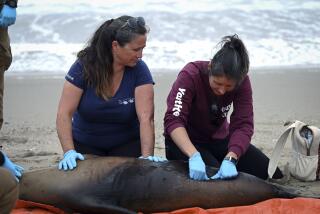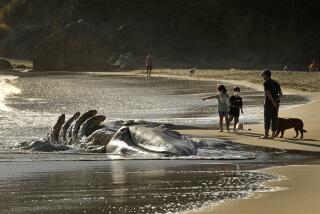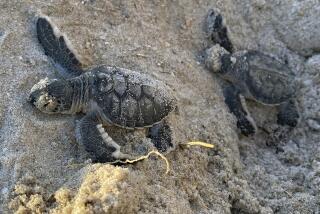Mass Sea Turtle Deaths Perplex Biologists
SAN SALVADOR — More than 100 dead and dying sea turtles have washed up on the beaches of El Salvador in the last 10 days, and marine biologists can’t explain what is killing them, officials said Friday.
Celina Duenas, an official with El Salvador’s Environment Ministry, said it was feared that the number of dead turtles could rise to 600 in the coming days.
An estimated 2,000 adult sea turtles live in the waters off El Salvador, said Carlos Drews, a sea turtle specialist with the World Wildlife Fund in neighboring Costa Rica.
The current outbreak could become one of the worst calamities to strike sea turtles in the Pacific Ocean, Drews said.
“The international conservation community is watching this and is very worried,” he said in a telephone interview.
A Salvadoran American fisherman first noticed “hundreds” of dead turtles floating in the water 40 miles off the Salvadoran coast on Dec. 30. After returning to shore, he sent an e-mail to environmentalists, Drew said. The fisherman wrote that the turtle carcasses drifted by his boat for eight hours.
The first 31 carcasses found on shore washed up Jan. 4 in the eastern Salvadoran province of La Union, according to news reports.
The animals weighed 70 to 150 pounds and had been dead at least four days, officials said.
At first, Salvadoran officials suspected that the animals had been caught up in fishing nets. Later they speculated that, as in other mass deaths of sea turtles, a red tide was responsible. Red tide is the excessive growth of algae that is sometimes linked to man-made pollution.
Red tide caused hundreds of turtle deaths off the coast of Oman in the Middle East in 2001, Drews said. But in that case, as in similar episodes, many other species were also killed. In the current outbreak, only sea turtle carcasses are turning up on beaches.
The sea turtles found Friday had died only a day or so earlier, officials said.
“Why this is happening continues to be a mystery,” Drews said. “Reptiles are very hard to kill. These animals don’t die of hunger easily. They can go weeks without eating.”
The biggest threat to sea turtles along the Mexican and Central American coasts comes from hunters who kill dozens at a time for their flesh and shells. But the sea turtle carcasses found in El Salvador have all been intact.
Duenas said a bacterial infection or pollution also could be behind the deaths. “If pollution is the cause, then the situation is even more serious, because not just the turtles could be in danger, but other species as well.”
On Friday officials discovered a sea turtle that was alive but dying. Scientists took blood and tissue samples from the animal for study, and a marine biologist from Florida was scheduled to arrive Sunday to help local researchers.
“In El Salvador, we don’t have any veterinarians who specialize in marine species,” Duenas said. “We have to depend on international support when these things happen.”
Turtles of three species have washed up on Salvadoran beaches: olive ridleys, hawksbills and black sea turtles. All are considered endangered species.
*
Times special correspondent Alexander Renderos in San Salvador contributed to this report.
More to Read
Sign up for Essential California
The most important California stories and recommendations in your inbox every morning.
You may occasionally receive promotional content from the Los Angeles Times.











